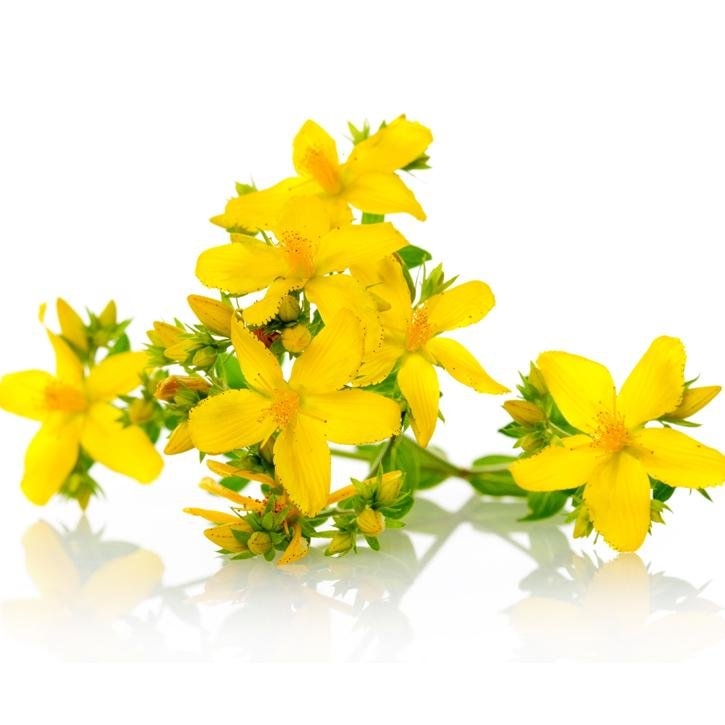The flowering tops.
Bibliography
Agencia Española del Medicamento. (2000). Real Farmacopea Española (1ª Edicion). Suplemento 2000. Ministerio de Sanidad y Consumo. Madrid.
Agencia Española del Medicamento. Nota informativa de la AEM sobre el riesgo de interacciones medicamentosas con Hypericum perforatum (Hierba de San Juan) 2000..
Brantner A.; Della Logia R.; Sosa S. y Karting T. Untersuchungen zur antiphlogistischen Wirkung von Hypericum perforatum L. Sci Pharm 1994; 62: 97-8.
Brondz I.; Greibrokk T; Groth P.A. y Aasen A.J. The relative stereochemistry of hyperforin – an antibiotic from Hypericum perforatum L. Tetrahedron Lett 1982; 23:1299-300.
Bruneton J. Pharmacognosy, phytochemistry, medicinal plants, 2ª ed. Paris: Tecnique & Documentation, 1999.
Buendia, E. El Hiperico en el tratamiento de la depresión. Revista de Fitoterapia 2000; 1: 37 - 42.
Denke A, Schempp H, Mann E, Schneider W, Elstner EF.. Biochemical activities of extracts from Hypericum perforatum L. 4th Communication: Influence of different cultivation methods. Arzneimittelforschung 49 (2): 120 - 125.
Editorial. Hipérico (Hypericum perforatum). The Medical Letter. 1998. 20 (1): 1 - 2.
Ernst, E. Second thoughts about safety of St. John´s wort. The Lancet. 1999; 354: 2014 - 2016.
Gordon, J.B. SSRIs and St. John´s wort: Possible toxicity?. An Fam Physician. 1998; 57 (5): 950 - 953.
Hänsgen, K.D.; Vesper, J. y Ploch, M. Multizentrische doppelblind-studie zur antidepressiven wirksamkeit des Hypericum extraktes LI 160. Nervenheilkunde 1993. 12: 285 - 289.
Hölzl J. Inhaltsstoffeund Wirkmechanismen des Johanniskrautes. Z Phytother1993;14: 255-64.
Hypericum Depression Trial Study Group. Effect of Hypericum perforatum (St John's Wort) in Major Depressive Disorder. A Randomized Controlled Trial. JAMA. 2002;287:1807-1814.
Izzo AA. Drug interactions with St. John's Wort (Hypericum perforatum): a review of the clinical evidence. Int J Clin Pharmacol Ther. 2004 Mar;42(3):139-48.
Johne A, Brockmoller J, Bauer S, Maurer A, Langheinrich M y Roots I.. Pharmacokinetic interaction of digoxin with an herbal extract from St. John´s wort (Hypericum perforatum). Clin Pharmacol Ther 1999; 66: 338 - 345.
Johnson D, Ksciuk H, Woelk H, Sauerwein-Giese E y Frauendorf A.. Effects of Hypericum extract LI 160 compared with Maprotiline on resting EEG and evoked potential in 24 volunteers. J Geriatr Psychiatry Neurol 1994; 7 (suppl.1): S44 - S46.
Lantz, M.S.; Buchalter, E. y Giambanco, V. St. John´s wort and antidepressant drug interactions in the elderly. J Geriatr Psychiatry Neurol 1999; 12: 7 - 10.
Lehrl, S. & al. Ergebnisse von messungen der kognitiven leistungsfähigkeit bei patienten unter der therapie mit Johanniskraut-extrakt. Nervenheilkunde 1993. 12: 281 - 284.
Linde K, Ramirez G, Mulrow CD, Pauls A, Weidenhammer W y Melchart D.. St. ohn´s wort for depression. An overview and meta-analysis of randomized clinical trials. BMJ 1996; 313(7052):253-8.
Nebel A, Schneider BJ, Baker RK y Kroll DJ.. Potential metabolic interaction between St. John´s wort and heophylline. Ann Pharmacotherapy. 1999; 33(4): 502.
Piscitelli SC, Burstein AH, Chaitt D, Alfaro RM y Falloon J.. Indinavir concentrations and St. John´s wort. The Lancet. 2000 Feb 12;355(9203):547-8. Erratum in: Lancet 2001 Apr 14;357(9263):1210.
Rey, J.M. y Walter, G. Hypericum perforatum (St. John´s wort) in depreession: pest or blessing?. Alternative Medicine 1998; 169: 583 - 586.
Roder C, Schaefer M y Leucht S. Meta-analysis of effectiveness and tolerability of treatment of mild to moderate depression with St. John's Word. Fortschr Neurol Psychiatr. 2004;72(6):330-43.
Rodriguez-Landa JF y Contreras CM. A review of clinical and experimental observations about antidepressant actions and side effects produced by Hypericum perforatum extracts. Phytomedicine. 2003 Nov;10(8):688-99.
Ruschitzka F, Meier PJ, Turina M, Luscher TF y Noll G. Acute heart trasplant rejection due to Saint John´s wort. The Lancet. 2000; 12;355(9203):548-9..
Schrader E. Equivalence of St. John´s wort extract (Ze 117) and fluoxetine: a randomized, controlled study in mild-moderated depression. Int Clin Psychopharmacol 2000; 15: 61 - 68.
Schinkel AH, Wagenaar E, van Deemter L, Mol CA y Borst P. Absence of the mdr 1a P-glycoprotein in mice affects tissue distribution and pharmacokinetics of dexamethasone, digoxin and cyclosporin A. J Clin Invest 1995; 96(4): 1698 - 1705.
Sommer, H. y Harrer, G. Therapie leichter/mittelschwerer Depressionen mit Hypericum. (Terapia de las depresiones ligeras/semiprofundas con Hypericum). Münch Med Wschr. 1993. 135 (22): 305 - 309.
Stevinson, C. y Ernst, E. Safety of Hypericum in patients with depression. CNS Drugs. 1999; 11 (2): 125 - 132.
Vorbach EU, Arnoldt KH y Hubner WD. Efficacy and tolerability of St. John's wort extract LI 160 versus imipramine in patients with severe depressive episodes according to ICD-10. Pharmacopsychiatry. 1997;30 Suppl 2:81-5
Vorbach, E.U.; Hübner, W.D. y Arnoldt, K.H. Effectiveness and tolerance of the Hypericum extract LI 160 in comparison with Imipramine: Randomized double-blind study with 135 outpatients. J Geriatr Psychiatry Neurol 1994; 7 (suppl. 1): S19 - S23.
